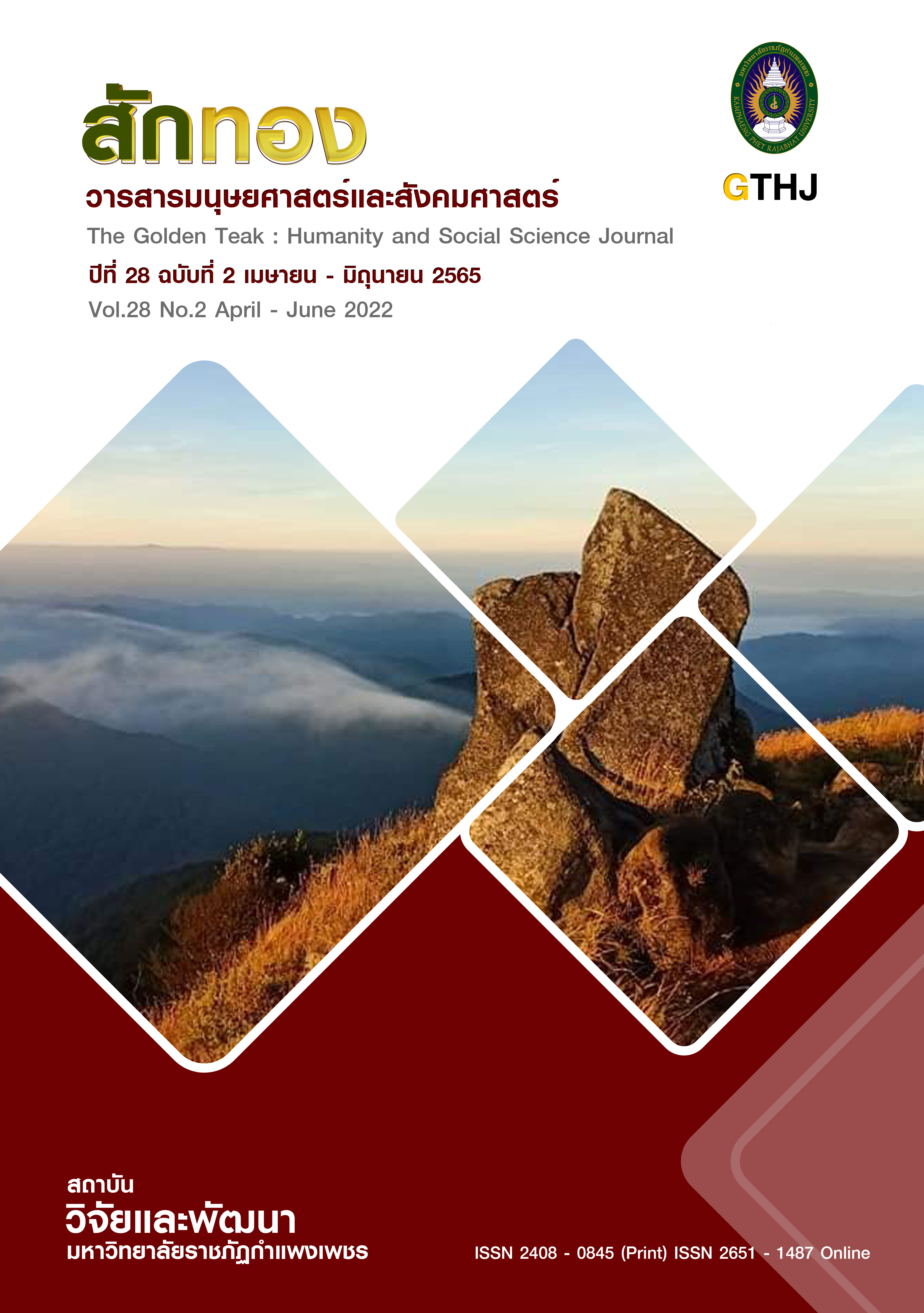Development of Instruction Package on Congruent and Incongruent Collocations of High-Frequency Verbs : Do, Get, Give, Have, Make, Take
Main Article Content
Abstract
The objectives of this research were 1) to construct on English instruction package on congruent and incongruent collocations of high-frequency verbs: Do, Get, Give, Have, Make Take, 2) to compare English collocations competency for Business English students in Humanities and Social Sciences Faculty, and 3) to examine the results of Varied-Spaced Repetition theory with the third-year students of Business English program. This package was analyzed from the theory of Instruction Package from Chaiyong Promwong (2013) and the theory of Varied-Spaced Repetition from Pimsleur (1967). The instruments were the instruction package to promote English collocations and an achievement test. The participants consisted of 30 students at Pibulsongkram Rajabhat University. The statistics used for the data analysis were the efficiency of values E1/E2 (80/80), mean, standard deviation, and dependent t-test. The results were as follows: 1) the instruction package was efficient since it had the efficiency values with Step 1(1:1) at 92.38/84.11, Step 2(1:10) at 92.62/86.17, Step 3 (1:100) at 86.36/86.17, 2) The skills after using the collocation instruction package of the experimental group were significantly higher than that before using it at the .05 level. 3) the varied spaced repetition method towards the package was at the high level.
Article Details

This work is licensed under a Creative Commons Attribution-NonCommercial-NoDerivatives 4.0 International License.
บทความที่ได้รับการตีพิมพ์เป็นลิขสิทธิ์ของวารสาร สักทอง : วารสารมนุษยศาสตร์และสังคมศาสตร์ สถาบันวิจัยและพัฒนา มหาวิทยาลับราชภัฏกำแพงเพชร
ข้อคิดเห็นใดๆ ที่ปรากฎในวารสารเป็นวรรณกรรมของผู้เขียนโดยเฉพาะ ซึ่งมหาวิทยาลัยราชภัฏกำแพงเพชรและบรรณาธิการไม่จำเป็นต้องเห็นด้วย
References
Anthony, L. (2014). AntConc (Version 3.5.8) [Computer Software]. [Online]. Available : http://www.laurenceanthony.net [2021, January 5].
Chimongkol, T. (2021). Congruent and Incongruent Collocations of High-Frequency Verbs: Do, Get, Give, Have, Make, Take. Liberal Arts Review, 16(1), 130-146.
Davies, M. (2004) British National Corpus (from Oxford University Press). [Online]. Available : https://www.english-corpora.org/bnc/ [2021, January 6].
_______. (2008) The Corpus of Contemporary American English (COCA): One billion million words, 1990-2019. [Online]. Available : https://www.english-corpora.org/coca/ [2021, January 10].
Ellis, N. (1996). Sequencing in SLA: Phonological memory, chunking and points of order. Studies in the Second Language Acquisition, 18, 91-126.
Ellis, N. & Beaton, A. (1993). Psychological determinants of foreign language vocabulary learning. Language Learning, 43(4), 559-617.
Hunt, A & Beglar, D. (1998). Current research and practice in teaching vocabulary. The Language Teacher. [Online]. Available : http://langue.hyper.chubu.ac.jp/ jalt/pub/tlt/98/jan/hunt.html [2021, January 17].
Michael, L.-C. (2013). Teaching Vocabulary. USA : TESOL International Association.
Nation, I.S.P. (2001). Learning Vocabulary in Another Language. Unites Kingdom : Cambridge University Press.
Nation, I.S.P & Macalister, J. (2009). Language Curriculum Design. Abingdon, Oxon : Routledge.
Nation, P. (2020). What matters in vocabulary learning?. In The Online Seminar held by Teaching English as a Foreign Language (TEFL), June 28, 2020. Bangkok : Chulalongkorn University.
Promwong, C. (2013). Media Performance Testing or Teaching Series. Silpakorn Education and Research Journal, 5(1), 7-20.
Purdon, J. (2010). The effect of Spaced Repetitions on Vocabulary Retention in Young Japanese Learners. Ritsukyõ jogakuin tannki daigakukiyõ, (42). 41-54.
Settles, B. & Meeder, B. (2010). A Trainable Spaced Repetition Model for Language Learning. In Proceedings of the 54th Annual Meeting of the Association for Computational Linguistics, August 7-12, 2016(pp.1848-1858). Berlin : Germany.
Goudarzi, Z. & Raouf Moini, M. (2012). The Effect of Input Enhancement of Collocations in Reading on Collocation Learning and Retention of EFL Learners. International Education Studies 5(3), 247-258.
Nakata, T. (2006). English collocation learning through meaning-focused and form-focused activities: Interactions of activity types and L1-L2 congruence. In Proceedings of the 11th Conference of Pan-Pacific Association of Applied Linguistics. 1 Janauary 2006 (pp.154-168). Rikkyo University : Japan.
Sanguannam, S. (2017). A study on “Delexical Verb+Noun” collocation errors of Thai EFL intermediate and advanced learners. Journal of Liberal Art, 17(2), 59-84.
Yamashita, J. & Jiang, N. (2010). L1 influence on the acquisition of L2 collocations: Japanese ESL users and EFL learners acquiring English collocations. TESOL Quarterly, 44, 647-668
Zhou, X. (2016). A corpus-based study on high frequency verb collocations in the case of “Have”. International Forum of Teaching and studies, 12(1), 42-50.


